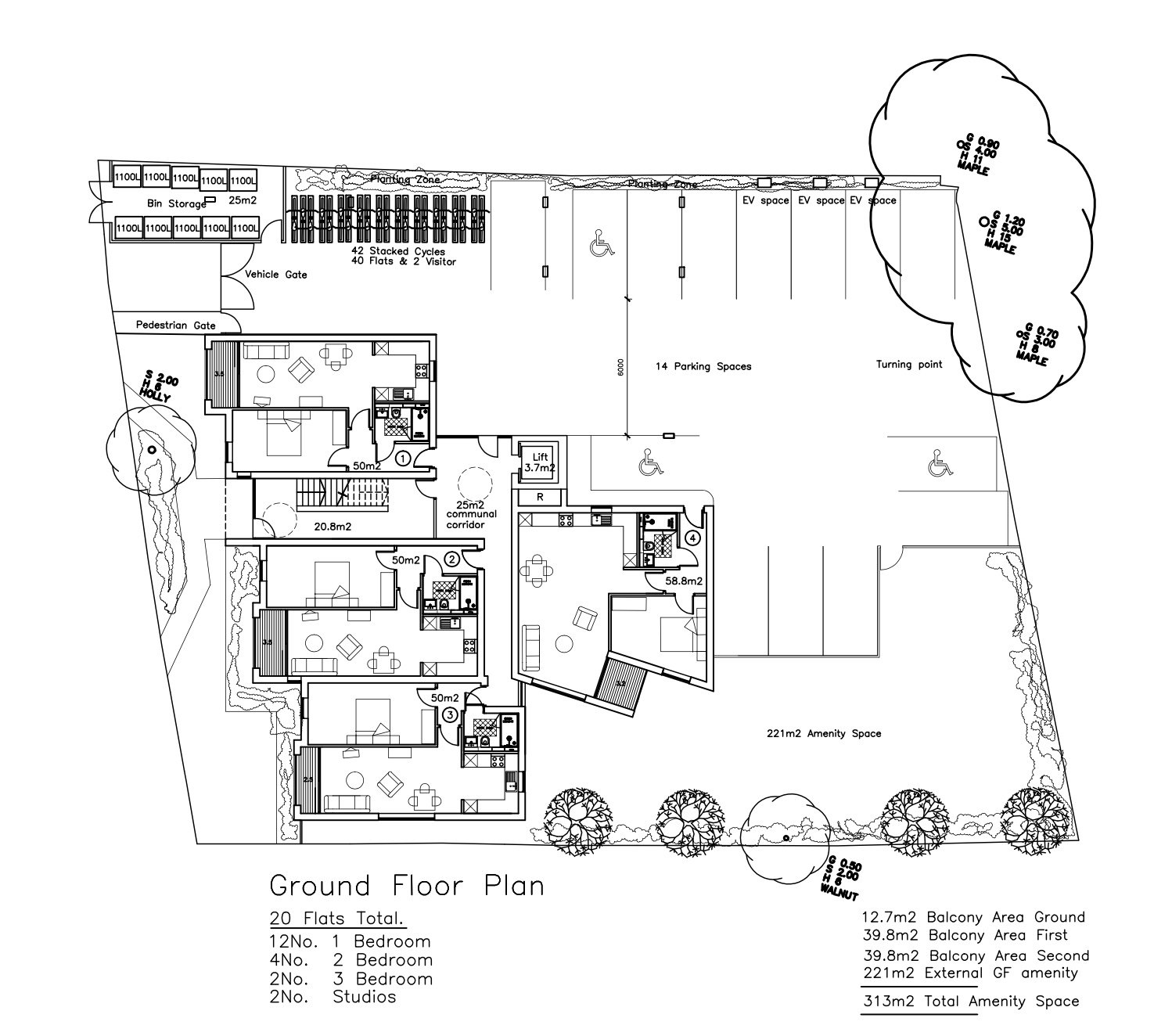Planning Tricks and Traps: How We Used Planning to Unlock £10 Million
David Kemp is the Director of DRK Planning Ltd. In this article, he shares some planning strategies they have used to significantly increase the value of one of their recent developments.
“It is not the strongest or most intelligent who will survive, but those who can best manage change.” Charles Darwin
New planning reforms in August 2020 opened up the possibility of new permitted development rights and new use classes. These changes have opened up the possibility of development on sites up until now ‘frozen’ in their current use due to local planning policy restrictions.
One such case we have been dealing with over the last 18 months demonstrates the need to adapt and be flexible as new opportunities arise, but also the challenge that this creates for dealing with local planning authority officers, who are themselves often trying to adapt to this change.
In this case, we took a site from a single-storey small community hall to a new three-storey development comprising 20 new apartments in North London, making use of changes to the Use Classes rules (as well as other planning strategies) along the way. The final planning permission unlocked about £10 million in development value, whilst delivering nearly half a million pounds in benefits to local amenity, transport, local schools and affordable housing.
Fewer cars, higher density!
The development site comprises a former church hall site, no longer used or needed by the church opposite for community use. This substantial site, located next to a primary school and within walking distance of buses, underground stations and local shops, was a great opportunity for a substantial new flatted development.
The site sits in a broadly residential area, in a location on the fringe of greater densities and building heights, and included large expanses of hard surfacing for car parking, creating the opportunity for a more environmentally-sustainable use of the site, returning more soft landscaping and far lower dependency on the car, with the benefit of extra family housing.
Therefore, in August 2020, we embarked on an application for planning permission for the redevelopment of this site into a new build three-storey apartment block for nine flats and commercial use on the ground floor.
We submitted an application for planning permission for the nine units scheme in late July 2020, following a successful pre-application, and then finally obtained planning permission in October 2020.
Submitting for planning for the nine units scheme before going back for 20 units, instead of going straight away for 20 units, had the following advantages:
A smaller number of units draws less attention locally and drew less opposition. The nine units scheme passed with fewer than five objections and under delegated powers.
No affordable housing is required in Barnet for less than 10 new units.
It creates a higher value than the existing use as community centre, which then means on larger schemes, the alternative use value established by this permission reduces the affordable housing contribution on a larger scheme.
Obtaining permission quicker and easier for a smaller scheme helps to raise money against the site which can then help to manage the costs and delays to the scheme in trying to obtain planning for a larger scheme.
An application for only nine units would not have required an on-street parking assessment, which for reasons explained below could not have been obtained during the pandemic.
It establishes a ‘baseline’ in terms of scale, mass, height and siting. The 20 units scheme was based on the same building envelope and same window openings. This massively narrows the possible grounds for objection and enhances planning prospects.
However, the pandemic and successive lockdowns impacted housing choice and the local housing market. Furthermore, the new London Plan 2021 was soon adopted, placing greater emphasis on the need to optimise housing development on brownfield sites, such as this.
These factors combined to trigger a significant re-think of the scheme and pave the way for a new application that would more than double the proposed number of dwellings in the scheme, without altering the size of the approved building.
As a result, we have finally obtained permission for 20 units on the site, on the basis of a similar siting and building envelope to that approved a year earlier in the nine units scheme. This will make the best use of a previously-developed site and provide new housing in the London Borough of Barnet in North London, reduce car parking and deliver an attractive, exciting and more environmentally-sustainable scheme.
We had to meet some unusual and interesting challenges on the way to this result.
Community uses
Any redevelopment of a site currently in a ‘community-related’ use, such as churches, community halls and medical uses, before September 2020, would have normally been heavily restricted.
Usually, the Council will want to see the replacement of at least the same ‘community use’ on site as part of their local planning policies, even if comprised within a residential-led mixed use scheme. This can cause conflicts with new flats above in some cases through increased noise and disturbance or traffic, but also limits the value-add of a sound commercial ground floor tenant, such as a Tesco Express or similar mini-market of strong covenant.
The Council had stated in earlier pre-applications for development of the site that, for this reason, it would not accept a full residential development of the site without replacement of the existing community facility. However, this opinion was expressed before the new use classes and new Use Class E (Commercial and Business Uses) came into effect in September 2020.
St. John’s Church no longer wanted or needed the church hall, as they were planning to build a new one on their site across the road. However, the Council would still look to retain it in community use until we could be sure that the Church had secured permission for and provided a new replacement facility on their new site. This significantly encumbered the residential opportunity by placing the fate of this site in the hands of a third party and the progress of their own, entirely independent planning application.
Always keep control of your own destiny
This would get very complicated if we went this path.
Firstly, you are in effect tying the fortunes of your own site to the planning prospects of another associated site when you have little or no control over the course of their planning application.
Secondly, it adds to costs and time as the way in which the Council would guarantee this reprovision across two associated sites would be through a Section 106 Agreement to be signed by the Council, my client and the Church. This is best avoided, especially when it comes to Church organisations and trust bodies in my experience, as I have had situations when in some cases they will not sign standard s106 clauses insisted upon by the Council – Planning law and Trust law do not always mix well together! It can basically become a nightmare of unending and avoidable legal complexity, draining cost, time and energy.
The Church’s own application for a new church hall remains undecided, nearly two and a half years after it was first submitted! This emphasizes the importance of not being tethered to the fortunes of another scheme beyond your own control.
Therefore, we initially retained a ‘community use’ on the ground floor of an equivalent size in the new scheme, although this soon changed with the change in the Use Classes Order in the Summer of 2020.
Making use of the new use classes
A church hall would fall within the new Use Class F1. There is no leeway in this use class to add to the capital or rental value of this use by either permitted development or movements within the same use class. However, before September 2020, the hall fell within the same use class as clinics, health centres and day nurseries – Use Class D1.
Therefore, we made use of the final days of the D1 Use Class and moved in a natural health and wellbeing operator (it does not have to be a traditional medical practitioner to fall into these categories). This was set up and in use before 1st September 2020.
To satisfy the lawyers and the planners, and as a matter of record, we obtained a Certificate of Lawfulness from the Council to confirm that the new use was a lawful Class E Use (Commercial, Business and Service Use). This also increased the potential value of the development by adding to the rental or capital value of the commercial part, especially as this could be valued on the basis of a retail or office premises instead, for which permission would not be needed as they are also in Class E.
Also, by taking the commercial space out of a ‘community-based’ use, this made it easier to avoid the Council’s more restrictive policies on community uses that would probably block any future conversion to residential, so a future residential conversion of this space might be more possible (with planning) or simply a transfer of the space in the scheme over to a higher value retail or business operation (without planning).
New Build and new Prior Approval for Class E
It is worth noting that the new Class E commercial unit created in this development would not benefit from the new Prior Approval rights under Class MA, which came into force from 1st August 2021.
This is because these rights will only benefit existing buildings in Class E use which are then converted, not buildings that are demolished and then redeveloped. All PD and Prior Approval rights are normally lost when a building is demolished.
Therefore, if we wanted to convert this space to residential in the future, then we would not be able to do so via PD rights. It would require an application for full planning permission. However, not sitting in a community use any longer would make this much easier to obtain.
Parking and highways and COVID-19
With a larger development than this, one would normally have to consider the capacity of the highway to take additional on-street car parking.
On-street parking surveys done during school holidays or a week or so either side are usually not accepted by local highway authorities (referred to as the ‘Lambeth Methodology’). The lockdown in the UK during the COVID pandemic therefore severely affected the developer’s ability to get this scheme in to the Council for a planning application. Other surveys were also affected at this time.
Therefore, the safest course of action was simply to proceed with a scheme for fewer dwellings where the amount of off-street spaces allocated in the scheme would easily satisfy the Council’s Parking Standards.
As a result, on-street parking surveys would not be needed, and this would not hold up the submission of the application for fewer units during lockdown.
Getting over the line: ‘community benefits’
We had to contend with a fair amount of local interest in the scheme – some 76 objections! However, the neighbouring primary school, being an academy school, would not have seen a penny of the £320,000 CIL contribution estimated to go to the Council. Therefore, we agreed a package of ‘green improvements’ and security measures that would directly benefit them. In return they agreed to withdraw their objection to the scheme which gave us a much smoother ride at Planning Committee. The cost of these measures could also be used to mitigate or offset any later affordable housing payments to the Council.
Therefore, overall, the final scheme will deliver local improvements totalling nearly half a million pounds, much-needed additional housing, a better and more environmentally-sustainable use of the site, and a scheme delivering a development value in the region of £10 million.






